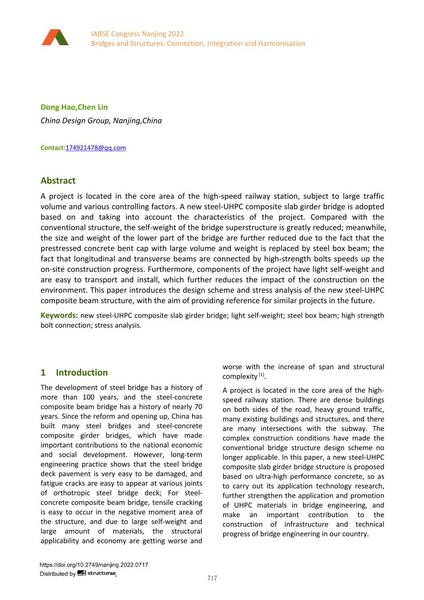Design and Application of New Steel-UHPC Composite Slab Girder Bridge

|
|
|||||||||||
Détails bibliographiques
| Auteur(s): |
Dong Hao
(China Design Group, Nanjing,China)
Chen Lin (China Design Group, Nanjing,China) |
||||
|---|---|---|---|---|---|
| Médium: | papier de conférence | ||||
| Langue(s): | anglais | ||||
| Conférence: | IABSE Congress: Bridges and Structures: Connection, Integration and Harmonisation, Nanjing, People's Republic of China, 21-23 September 2022 | ||||
| Publié dans: | IABSE Congress Nanjing 2022 | ||||
|
|||||
| Page(s): | 717-723 | ||||
| Nombre total de pages (du PDF): | 7 | ||||
| DOI: | 10.2749/nanjing.2022.0717 | ||||
| Abstrait: |
A project is located in the core area of the high-speed railway station, subject to large traffic volume and various controlling factors. A new steel-UHPC composite slab girder bridge is adopted based on and taking into account the characteristics of the project. Compared with the conventional structure, the self-weight of the bridge superstructure is greatly reduced; meanwhile, the size and weight of the lower part of the bridge are further reduced due to the fact that the prestressed concrete bent cap with large volume and weight is replaced by steel box beam; the fact that longitudinal and transverse beams are connected by high-strength bolts speeds up the on-site construction progress. Furthermore, components of the project have light self-weight and are easy to transport and install, which further reduces the impact of the construction on the environment. This paper introduces the design scheme and stress analysis of the new steel-UHPC composite beam structure, with the aim of providing reference for similar projects in the future. |
||||
| Copyright: | © 2022 International Association for Bridge and Structural Engineering (IABSE) | ||||
| License: | Cette oeuvre ne peut être utilisée sans la permission de l'auteur ou détenteur des droits. |
||||
